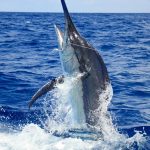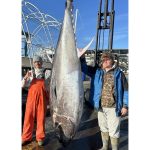Article Courtesy: anglersjournal.com | Originally Published: 6/29/2021 | Click here for original article
A Last, Best Place
Photos by Jessica Haydahl Richardson
As the skiff sped through the labyrinth of marsh channels, I gave silent thanks for modern electronics. Every time I’m lucky enough to fish in the vast system of wetlands along the border of Louisiana and Mississippi, I have a vague feeling that I might never find my way out. At the very least, I might spend a night on the boat.
Such concerns constitute paranoia, of course, because anglers plied these waters for many decades before GPS came along. As far as I know, they all made it home in one piece. Still, the sheer size and scope of this area can be intimidating, especially to those of us from places where navigation requires less skill.
Hopedale, Louisiana, sits at the end of state road LA 624 on the western edge of this wild sea of grass and water, known both as the Mississippi Marsh and the Biloxi Marsh, depending on whom you ask. I’ve sought clear definitions of boundaries, and although I suspect they exist, I’ve yet to have them adequately explained to me. Not that it matters. A huge number of trophy fish call this place home, and the fishing pressure remains light on most days. That’s what counts.
Capt. Alex Murray — whose electronics worked well when I was aboard with him — calls the myriad small bayous that dot the marsh “duck ponds” because during the winter, waterfowl flock to this area in incredible numbers. “My favorite thing about Hopedale and why it’s such a special place is the environment that you are fishing,” Murray says. “It’s a maze of marshy shorelines, duck ponds and small islands on the exterior of the marsh. It gives you a diverse fishery and many places to fish during any season and weather condition.”
Fishing the Ponds
The waters off Hopedale differ substantially from the marsh farther south, around Venice, Houma and Grand Isle. Those areas offer outstanding redfish action, as well, but the water tends to be clearer east of Hopedale, creating spectacular sight-fishing opportunities. “I love sight fishing for redfish in the fall and winter in the Biloxi Marsh,” Murray says. “The big redfish will school up on the exterior of the marsh and in duck ponds, making a perfect sight-casting opportunity with lures or flies.”
As Murray used the electric trolling motor to nudge our bay boat around the perimeter of the first bayou we entered, we could see telltale puffs of mud up ahead. A school of 20 or more redfish nervously moved along the shoreline. Our day had dawned calm and clear, and in such settled conditions it can be difficult to sneak up on wary fish using a trolling motor. Poling a skiff can work better, but we didn’t have that option.
We stopped to let the fish settle, and soon they came to us. We cast soft plastic baits and picked off fish after fish. The school would scatter when a fish got hooked, but after the release, the lot of them tended to school up again and afford us another shot. My fishing companion on the trip, Capt. Jared Cyr of Key West, Florida, pulled out the fly rod after we’d caught and released several on spin.
On the Fly
“Let’s see if we can get a lighter presentation with the fly,” Cyr says as he casts a crab fly that Murray had tied. It landed near a group of reddish backs feeding next to a mud bank. Cyr got maybe two strips into his retrieve when the rod bent hard. He found himself securely buttoned to yet another chunky redfish. Over several days we repeated this scenario again and again in dozens of bayous and along the edges of grass islands lining the Gulf of Mexico.
The expanse of habitat supports a variety of forage species for redfish and other gamefish, and the fishing options seem almost limitless. On another trip to Hopedale, Capt. Ronnie Daniels took me to a different section of the marsh. During that winter trip a stiff, cold wind blew from the Northeast, creating challenging conditions. The water had been blown out of some bayous, and we were unable to get into places Daniels wanted to fish. Farther into the marsh, we found a deeper bayou where the wind pushed water hard into a corner of the bay that was lined with tall stands of roseau cane. We staked off the boat with the Power-Pole and began casting downwind into the pocket, where waves battered the mud bank in the breeze. Redfish struck our baits on nearly every cast, and we spent the better part of 45 minutes releasing fish. The magic ended as suddenly as it had begun, but only after yet another spectacular episode of Louisiana redfishing.
End of the Road
Venice sits at the end of the road south of New Orleans and gets a lot more attention as a fishing mecca than Hopedale. Venice affords access to inshore and offshore species that’s virtually unrivaled anywhere in the continental United States. You can target redfish and speckled trout inshore, then jump offshore for red snapper, yellowfin and blackfin tuna, wahoo, king mackerel, blue marlin and more. The fish around the Louisiana Delta run big and are usually plentiful, adding credence to Louisiana’s self-described status as the “Sportsman’s Paradise.”
After our first Hopedale expedition, Cyr and I made our way south to Venice for a fishing-and-hunting trip. Bart Haddad, managing partner of the Dogwood Lodge in Hopedale and the SWC Sportsmans Lodge in Venice, set up everything for us, and we spent a morning in a blind just off the Mississippi River experiencing an epic duck hunt. After shooting our limit, we returned to Venice for an afternoon of inshore fishing.
Capt. Dan Skermetta picked us up, and we headed off into the marsh in search of reds. We came around a few corners to see something that distinguishes Venice from Hopedale: awesome natural beauty combined with the remains of the oil industry, which dominates this part of the world. You can be running in pristine conditions, round a bend and find a dozen abandoned wellheads and a gnarled forest of old pipes jutting from the bottom. Such is the nature of southern Louisiana.
One More Spot
Skermetta took us south to where the marsh meets the Gulf, and we worked the edges of several bayous with moderate success. We had caught and released perhaps a dozen redfish in a slow pick and still had a long run ahead of us to get home when Skermetta suggested trying one more spot.
We came upon a shell beach where waves crashed from a persistent southerly breeze from the open Gulf. It took a minute to realize what we were looking at, but the three of us soon made out the backs of giant redfish cruising back and forth in the surf, smashing into schools of terrified mullet along the beach. Skermetta positioned the boat just outside the surf break, and Cyr and I positioned ourselves to make long casts into the melee.
Cyr connected first, hooking a redfish of probably 25 pounds on a spinning rod with a shrimp-tipped jig. The boat pitched in the surf, creating difficult conditions and the need to be aware of oncoming waves while trying to make an accurate cast. But as we figured out the feeding patterns, we dialed in our casts and began steadily hooking big fish.
We enjoyed this terrific action until the sun sat just above the horizon, and Skermetta finally made us pull up and head for home to avoid running in the dark. That intense burst of action, though brief, remains the single best day of redfishing I’ve ever experienced. Our smallest fish weighed about 20 pounds. The largest easily pushed 40.
Rig for Success
Such stories abound in southern Louisiana. A lot of folks prefer the offshore action in the Gulf of Mexico, where thousands of oil and natural gas rigs attract baitfish and predators — lots of predators. Although a variety of fish call the northern Gulf home, the yellowfin tuna reigns supreme for most offshore anglers. If you spend much time hanging around the fish-cleaning table at Venice Marina, you might wonder how there can be any tuna left in the Gulf. On fishable days, boats unload dozens of big yellowfin, and customers go home with coolers packed tightly with hundreds of pounds of fresh sushi. It’s an impressive ritual, one repeated at many marinas scattered throughout the area.
There are thousands of tuna around the rigs, creating what may be the best opportunity for hooking yellowfins anywhere in U.S. waters. “You have the chance of catching a quality yellowfin offshore of Venice 365 days a year,” says Capt. Trey Pique of the Voodoo Sportfishing fleet. “You might have to move around to find them at different times of the year, but they’re always around somewhere.” No other place I know of can credibly make that claim.
I filmed an episode of Anglers Journal TV with Pique this past spring and enjoyed awesome action around one of the “floater” rigs in 5,400 feet of water. These rigs remain in position thanks to sophisticated dynamic positioning technology, which uses GPS guidance systems tied into powerful underwater thrusters. The fish love it.
Pique and I drifted chunks of cut bait up-current of the rig after marking large schools of fish down deep. We picked off fat tunas between 70 and 100 pounds. The sheer force of a large tuna fought on conventional stand-up gear constitutes one of the more intense fishing experiences. There’s nothing quite like the pull of a powerful fish on stout tackle to test one’s angling mettle.
Among the other things I appreciated that day was the speed our boat offered. In the offshore fishery of Venice, center consoles capable of a 50-mph cruise have become the norm because of the distances you must typically cover to get to the fish. The open Gulf lies about 26 nautical miles south of Venice, down the Mississippi River, and the rig your captain wants to target may lie another 60 or 70 miles offshore, or more.










